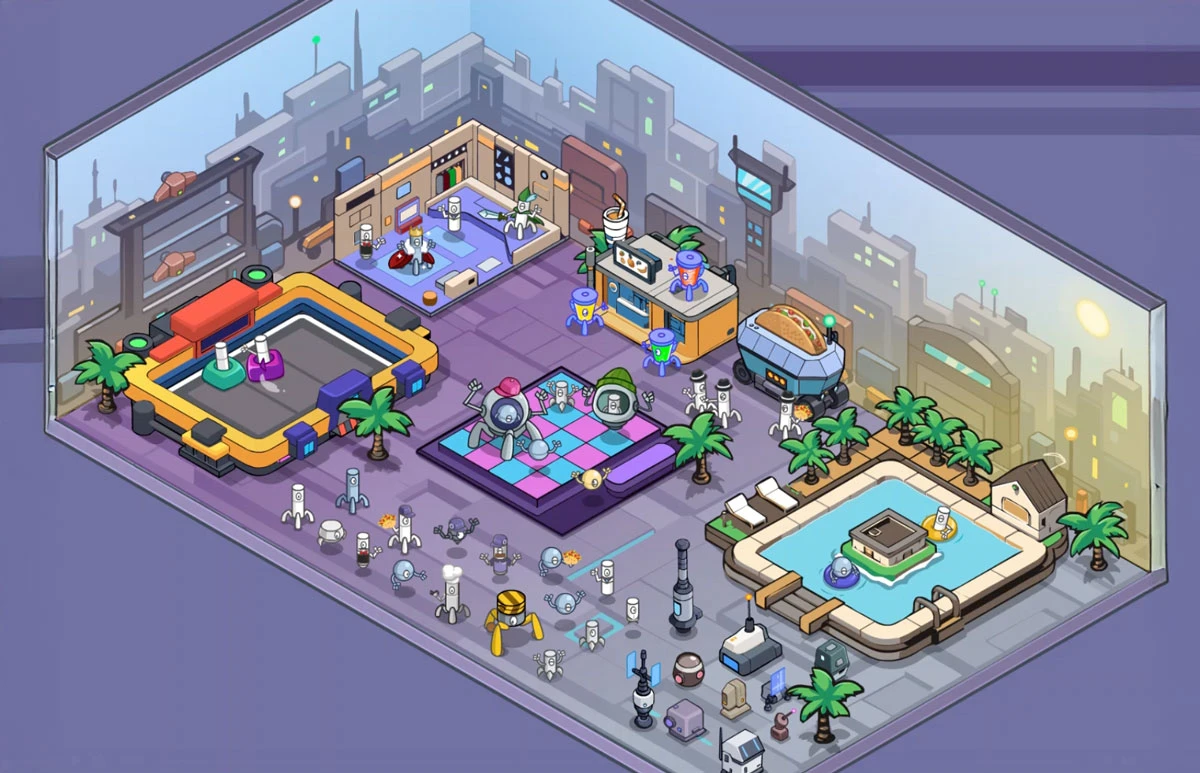
You’ve asked, “Is there a Sector 3 in Frax?” Yes! And the wait is over—Frax Sector 3 is here! Take a look at what’s available with this new Frax expansion and hear from the team behind Frax who helped bring the galaxy to life.
What is Frax Sector 3?
Frax is an adaptive and game-based program that helps students develop a conceptual understanding of fractions. Throughout their Frax journey, students progress through missions grouped by Sectors that align to elementary grade-level fractions standards. Each mission is structured as a game-based challenge, allowing students to learn by doing as they progress through carefully scaffolded instruction.
The all-new Sector 3 allows students to apply the foundational skills they developed in Sectors 1 and 2 to perform advanced operations with fractions, focusing largely on fraction arithmetic.
Building on Frax Sectors 1 and 2
Dan Moriarty, ExploreLearning Product Designer and former high school math teacher, has worked to develop and improve Frax for the past five years. Prior to Frax, he used his math background to build an extensive collection of Gizmos math simulations.
“Frax Sectors 1 and 2 are mostly conceptual understanding for students. It's the real foundation of everything,” said Dan. “That's where we lay the groundwork for students' understanding of fractions as lengths and numbers on the number line. Sector 3 is really where it all comes together and where students start to learn the algorithms.”
New fraction concepts and features in Sector 3
What topics can you look forward to in Sector 3?
Key fraction concepts
- Adding and subtracting fractions with unlike denominators
- Multiplying fractions
- Dividing fractions
- Simplifying fractions
- Converting between mixed numbers and fractions greater than one
Exciting additions for students
- Engaging storylines
- Brand new games
- Expanded rewards and new ways to spend hard-earned tokens
Why starting with Frax Sector 1 matters
“Sector 3 is different from Sectors 1 and 2 because it's kind of the capstone. It's the thing that we've been building towards this whole time,” said Jesse Mercer, Senior Product Designer at ExploreLearning. “Sector 3 is using all of that really important foundational conceptual understanding and skills that they learned in Sectors 1 and 2, and now applying it to that hard stuff.”
Mercer, a 13-year teaching veteran, witnessed the importance of fractions firsthand with his Algebra 1 students. “I signed up to this because this is the product that I wanted my eighth graders to have because they were coming to me not knowing how to do fractions,” said Jesse. “Algebra 1 is really that moment where that door shuts for a lot of kids. What research is beginning to show is that yes, it’s Algebra 1 where the door shuts, but it’s already starting to close in fifth grade or fourth grade with fractions….Algebra 1 is difficult for a number of reasons, in particular because it’s this really big step from concrete mathematics to abstract mathematics, which high school math is all about. But that move towards abstraction actually starts in fractions.”
“Sectors 1 and 2 focused hard on how to use a number line,” said Jesse. Through game-based instruction, students become comfortable placing fractions on a number line and also reasoning with fractions to compare them, recognize equivalent fractions, and more.
“They've been comparing these unlike fractions since Sector 1. Now, they're adding them. It's this incremental step. It's a hard one for all kids, but it's not a leap anymore. It's a step because they've gone through Sector 1. They did Sector 2, where we introduced that fractions can be added just like normal numbers. We worked with adding like and subtracting like fractions or fractions with the same denominators. We made it really intuitive on the number line again,” said Jesse.
Inside the development of Frax Sector 3
“I think any math teacher out there would tell you that if there's one foundational piece in a student's math education that you wish you could target and fix, it would be fractions, because it would make all the rest of the math that comes more accessible,” said Dan.
With a laser focus on fractions, Dan and Jesse worked with fellow Frax teammates Heather Spence, Faith Peddie, Jeff Bowers, and Paul Cholmsky to develop and refine Sector 3 to be classroom-ready for students.
Joseph Brudlos, ExploreLearning’s Art Director, was another key player in bringing the Frax games and characters from concept to reality. Overseeing the storyline, game artwork, animations, and even the characters’ voices, Joseph works to transform the math concepts students need to practice into engaging and fun activities.

Jesse Mercer, Product Designer

Dan Moriarty, Product Designer

Joseph Brudlos, Art Director
Go Behind-the-Scenes with Frax Sector 3!
“We think that Sector 3 is going to take all of the threads that we've been working on in Sectors 1 and 2, and tie them into this bow, and send kids on into middle school ready to be successful.”
–Jesse Mercer, Senior Product Designer
Frax characters that engage students
For Joseph, making engaging math games isn’t just professional, it’s personal. “When I was a kid, I was terrible at math. In second grade, I was so disinterested in it.” But when he designed elements for Reflex, a game-based math fact fluency platform, his tone shifted. “When I worked on Reflex, like, Oh my gosh, if I'd had this when I was a kid, I would have been fine at math…. It would have been great. It would have spoken to how I learned. I was really impressed with Reflex, and I'm glad we're doing it with Frax.”
Outside of designing the Sector 3 games and imagery, Joseph was instrumental in developing the entire Frax galaxy spanning across Sectors 1 through 3, including the characters’ names, personalities, and back stories. Ever wonder who does the voices for the characters in Frax and Reflex? Joseph does those, too!
Brudlos leads the design, animation, and voices of the Frax characters.
“I think if you can engage a kid and make him excited about what he's doing, or looking forward to what's going to happen to the crew next, and make the games interesting, you know? I think there's a lot to be said about engagement, and that's why I think gamifying math is a great idea,” said Joseph.
Preparing for paper and pencil work with Ancient Wisdoms
Ancient Wisdoms is a new feature students can look forward to in Sector 3. “It's this great environment for essentially mimicking paper and pencil work that we want students to be able to do, but it's still happening on the screen. It's where they are doing the adding, subtracting, multiplying, and dividing. It's a cool setting. It's a lot more engaging than their old paper and pencil, but it looks a lot like paper and pencil,” said Dan. “We want to be sure that even when students are done with Frax and they go to their homework or a test or a standardized test, that even in that sort of sterile environment, they can answer these questions there too.”
“The idea is that you go down this planet and you dig for math rules. Then, you go to these dig sites where there are these sorts of ancient sites, and you find these relics. But you also find gems. The gems are basically an incentive for the student to use paper and pencil,” said Joseph.
Taking personalization further with BotLand
“In Sectors 1 and 2, students have had their cabins that they can decorate, and what we call Happy Acres, which is a fun simulated farm. For the tokens that they're earning in all the games, that's where they can buy things and decorate something, and make it cool,” said Dan. “We do have a new room coming for Sector 3 called BotLand. If the student testers are any guide, kids are really excited. They're just intrigued, and they want to see what this new room is going to be.”

BotLand in Sector 3
How teacher feedback shaped Sector 3
The Frax team knows that it’s important to always keep the student in mind when developing and refining the games and instructional content. “Student testing is something that we've used extensively throughout the development of Frax. Every time a new game comes out, a new mission, new content, we want to see how it plays with real kids,” said Dan.
Using play testing video footage, Dan, Jesse, and the team work together to see students’ reactions in real-time to help identify misconceptions, places where they got stuck, or areas where directions weren’t clear. “We change the product before it ever goes out the door to correspond to what these actual students showed us actual kids think,” said Jesse.
Dan also supports continuous refinement on the Content Evolution team. “The data analysis portion is something we've already done with Sectors 1 and 2 because they have been out there for a while. Once Sector 3 has been out for let's say six months or a year, that's our first chance to get a look at the data. We'll get some data back from the logic team and take a look at how long the activities are taking and where any struggles might be. We'll be looking at the content to see if we can really polish it up and make it function even better than it was originally.”
Enhance fraction instruction with Frax
With Frax, students don’t just practice fractions—they build a lasting mastery of fractions that paves the way for future math success. Teachers also reap the benefits as students progress through Sectors 1, 2, and 3.
“It's humanly impossible to give meaningful feedback simultaneously to a classroom full of kids as they're learning to use rulers or number lines. Each one is making their own individualized mistake and needs individualized feedback. A computer program, however, can provide just that kind of just-in-time feedback, which frees up that time for teachers to do what only they can do,” said Jesse. “Talk to the kid who hasn't had breakfast. Comfort the child who just lost her grandmother. Help kids interact with each other, kids from different backgrounds. Help them work in collaborative groups. Help them have those important discussions about mathematical concepts— face-to-face discussions. No computer, not even with AI, will ever be able to do that. Only a teacher can do that, right? We want to unlock a teacher's ability to do that with all of her students. That's what Frax is really about.”
Experience the research-based Frax today with a free classroom trial to start Sector 1 today.
It’s an exciting time for fractions! Contact our team today to learn how to bring Frax to your district, school, or classroom.